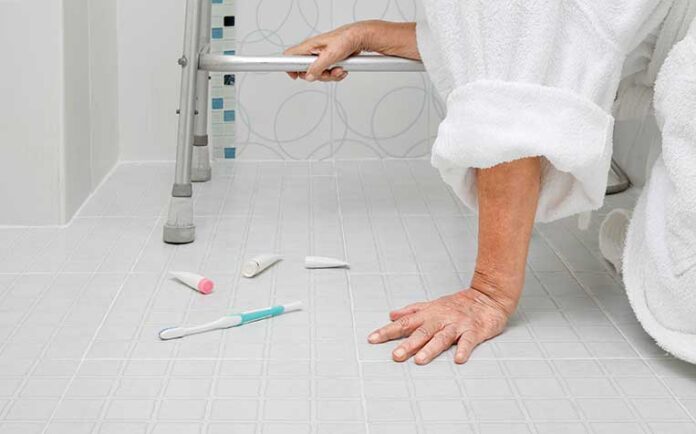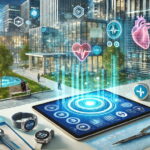There are many new challenges and dangers that come along with a dementia diagnosis. Patients with Alzheimer’s and similar conditions can struggle in many ways, finding it hard to express their thoughts and feelings, look after themselves, and remember things.
They’re also at greater risk of slipping, tripping, and falling, which can lead to serious harm in elderly patients with weaker bones and bodies. Fortunately, there are a variety of fall prevention systems and devices to make life safer and easier for these patients.
Importance of Fall Prevention for Individuals With Dementia
Sadly, patients statistics show that patients with dementia are up to five times more likely to fall compared to older people without any kind of cognitive impairments. They tend to have more frequent falls, and each fall represents a risk of serious injury.
Indeed, when patients with dementia do fall, reports suggest that they’re up to three times likelier than others to suffer fractures, broken bones, and end up in being hospital or even long-term care.
This is why, just as dementia toys and communication strategies are vital in caring for and communicating with dementia patients, fall prevention systems are also crucial to help keep them upright and minimize the risk of bad trips and injuries.
Traditional Approaches to Fall Prevention
Fall prevention devices and systems have been in use for many years. Some of the most traditional methods include physical items to help prop up and support the patient, such as walking sticks, canes, zimmer frames, and so on.
In addition, stair gates, handles, and other supportive structures can be installed around the home or rooms of dementia patients, giving them things to hold onto and support them when walking around, using the bathroom, and so on.
Innovative Medical Devices for Fall Prevention
While traditional fall prevention methods can be useful and have helped to prevent falls and protect elderly patients for many years, they have their problems. They won’t always protect people, and when falls do happen, those traditional methods provide little help to get patients back up and on their feet.
That’s why many medical device manufacturers and researchers have been looking into new, innovative ways to help reduce the risk of falls in patients with cognitive difficulties. Their efforts have led to the development of some very useful and effective devices, including the following.
GPS Tracking Devices
GPS tracking devices can be very helpful for patients who may not require full-time care and are able to live independently or with family, but are still at risk of possibly falling and hurting themselves, due to their condition.
These devices can be affixed to an elderly person’s clothing or accessories, like bags. Once activated, they emit a signal, allowing carers and loved ones to track the movements of the patient. If the signal seems to be stuck in one place, it may suggest that the patient has fallen and requires assistance, so family members can head over and help out quickly and efficiently.
Fall Detection and Alert Systems
There are also now medical alert systems with built-in fall detection technology. Ideal for patients who are at an elevated risk of falling over, these little devices work through the use of sensors, which detect if and when a fall occurs.
What’s more, these devices also have built-in alert systems, so they can automatically send a signal out to a medical care provider or an emergency contact if the patient falls, letting them know and making sure that help can arrive as quickly as possible. This can be so important, as there are many cases of patients being stuck on the ground for hours waiting for help.
Mobility Aids and Adaptive Equipment
One of the simplest ways to prevent elderly people with dementia from falling is through the use of mobility aids, such as wheelchairs and stair lifts that help these patients get around or even ascend the stairs without having to walk.
There have been great advancements in the industry of mobility aids in recent years, with new robotic technologies and safer systems to help patients enjoy great range of movement, more flexibility, and superior standards of security to reduce the odds of unexpected falls and injuries.
Research and Development of New Devices
The best part about all of this innovation is that it’s not stopping. Research and development of new mobility aids and other fall prevention devices is ongoing, with many of the world’s top medical developers working hard to produce new gadgets and technologies to keep people safe.
Assistive Technology
The term “assistive technology” typically encompasses a range of mobility devices like walkers, along with hardware, digital solutions, and other innovations, all geared towards helping those with disabilities or disadvantages to access and utilize information technologies, like computers, phones, and so on.
Again, we’re also seeing big improvements in this field, with simplified phone and computer interfaces that are easier for elderly patients with cognitive troubles to understand and utilize. With ongoing research, hopes are high that dementia patients will have so many more ways to express themselves through this kind of technology in years to come.
Conclusion
Clearly, individuals with dementia need as much help as possible in many aspects of life, particularly in regard to physical safety. Thanks to these great advancements, dementia patients are safer than ever, and with ongoing improvements, their standards of life should only increase in the future.
Did you find this article helpful? You can check out our website for more awesome content like this.
Read Also
- Optimizing CT Protocols: The Hidden Key to Efficiency and Cost Savings in RadiologyIntroduction: Why CT Protocol Optimization Matters Computed Tomography (CT) is a cornerstone of modern diagnostic imaging, providing critical information across nearly every medical specialty. However, maximizing the value of CT — both clinically and financially — requires more than just advanced hardware. The real secret lies in the optimization of CT protocols. When CT protocols… Read more: Optimizing CT Protocols: The Hidden Key to Efficiency and Cost Savings in Radiology
- The Role of Carbide Burs in Modern Dental ProceduresAs a result of this procedures need to be well coordinated and to this end, precision tools are used by dental practitioners. Among the most essential tools in a dentist’s arsenal are carbide burs, which have revolutionized various aspects of dental work. Today’s dentistry cannot work without these tools as they are both strong, sharp,… Read more: The Role of Carbide Burs in Modern Dental Procedures
- Detection of Diabetic Retinopathy: The AI AdvantageDiabetic retinopathy (DR) is a leading cause of blindness among working-age adults, affecting millions worldwide. The prevalence of DR is alarmingly high, affecting an estimated 34.6 million people globally. In the United States alone, it is estimated that 7.7 million adults have some form of diabetic retinopathy. How Does Diabetes Affect the Eye? Most of… Read more: Detection of Diabetic Retinopathy: The AI Advantage
- Advances in Digital Health: Transforming Modern HealthcareThe healthcare landscape is undergoing a seismic shift with the advent of digital health technologies. These innovations are not just modern conveniences; they are transformative tools that bridge gaps in accessibility, improve patient outcomes, and empower individuals to take charge of their health. From wearable devices to telehealth and artificial intelligence, digital health is creating… Read more: Advances in Digital Health: Transforming Modern Healthcare
- The Latest Advancements in Urology ProceduresUrology, the branch of medicine concerning the urinary system and male reproductive organs, has seen remarkable advancements in recent years. Technological innovations have led to more precise, less invasive, and increasingly successful procedures that promise better outcomes for patients. From state-of-the-art robotics to personalized medicine approaches, the field of urology is evolving at a rapid… Read more: The Latest Advancements in Urology Procedures






